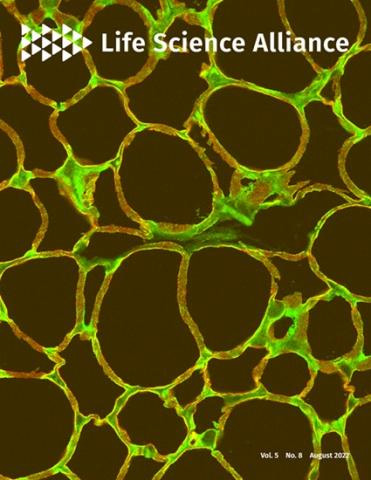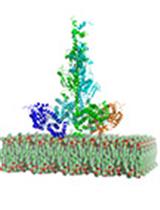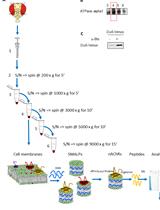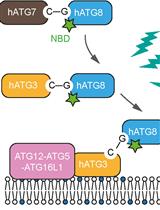- EN - English
- CN - 中文
Phospholipid Preparations to Characterize Protein–Lipid Interactions In Vitro
用于表征体外蛋白质-脂质相互作用的磷脂制剂
发布: 2023年11月20日第13卷第22期 DOI: 10.21769/BioProtoc.4887 浏览次数: 1109
评审: Julie WeidnerJohn P PhelanPhilipp A.M. Schmidpeter
Abstract
The lipid bilayers of the cell are composed of various lipid classes and species. These engage in cell signaling and regulation by recruiting cytosolic proteins to the membrane and interacting with membrane-embedded proteins to alternate their activity and stability. Like lipids, membrane proteins are amphipathic and are stabilized by the hydrophobic forces of the lipid bilayer. Membrane protein–lipid interactions are difficult to investigate since membrane proteins need to be reconstituted in a lipid-mimicking environment. A common and well-established approach is the detergent-based solubilization of the membrane proteins in detergent micelles. Nowadays, nanodiscs and liposomes are used to mimic the lipid bilayer and enable the work with membrane proteins in a more natural environment. However, these protocols need optimization and are labor intensive. The present protocol describes straightforward instructions on how the preparation of lipids is performed and how the lipid detergent mixture is integrated with the membrane protein MARCH5. The lipidation protocol was performed prior to an activity assay specific to membrane-bound E3 ubiquitin ligases and a stability assay that could be used for any membrane protein of choice.
Keywords: Membrane protein–lipid interaction (膜蛋白-脂质相互作用)Background
Membrane proteins interact with their lipid environment with the hydrophobic and hydrophilic patches of their transmembrane domains via a specific binding site (non-annular lipids) or the physiochemical properties of the lipid bilayer (annular lipids) (Contreras et al., 2011; Stangl and Schneider, 2015). These protein–lipid interactions can alter the activity, stability, folding, or localization of the target protein, leading to various cellular signaling events (Engelman, 2005; van Meer et al., 2008; Corradi et al., 2019a;). The characterization of these signaling mechanisms and the corresponding lipid–membrane protein interaction is a constant challenge due to the inherent phase difference imposed on the system from the presence of a mixture of detergent/lipid, lipid/protein, and detergent/lipid/protein (Sych et al., 2022). Therefore, research into the mechanisms used by lipids to regulate protein function and structure is restricted to a small number of membrane protein systems, often because of the technical difficulties as well as complexity associated with handling these systems in a laboratory setting (Fahy et al., 2009). Hence, understanding the mechanism of how lipids can modulate the activity of a specific membrane protein and the identification of the lipids that interact with the membrane protein of interest is often still an open and fundamental research question (Corradi et al., 2019b).
Phospholipids are the most abundant lipids in mammalian membranes and are characterized by their hydrophilic head group and their hydrophobic tail, which is built by two fatty acid chains. These fatty acid chains can vary in length and saturation, creating an immense variety (Horvath and Daum, 2013; Cockcroft, 2021). The chemically diverse hydrophilic head groups define the lipid classes (Table 1), whereas the different lengths and saturation subdivide the class in different lipid species (Liebisch et al., 2020). The lipid composition of the lipid bilayer is specific to the tissue and the cellular compartment, which comprises a distinct set of phospholipids (Table 1) (Ernst et al., 2016).
Table 1. Overview of phospholipids, their chemical characteristic, and the abundance of subcellular fractions [plasma membrane, mitochondria, and endoplasmic reticulum (ER)) of rat liver (Horvath and Daum, 2013)]
| Phospholipid class | Characteristic | Abundance in cellular compartment (%) | ||
|---|---|---|---|---|
| Plasma membrane | Mitochondria | ER | ||
| Phosphatidylethanolamine (PE) | zwitterionic | 40 | 34 | 60 |
| Cardiolipin (CL) | anionic | 1 | 14 | 1 |
| Phosphatidic acid (PA) | anionic | 1 | < 1 | 1 |
| Phosphatidylcholine (PC) | zwitterionic | 24 | 44 | 23 |
| Phosphatidylglycerol (PG) | anionic | - | - | - |
| Phosphatidylinositol phosphate (PI) | anionic | 8 | 5 | 10 |
Nowadays, different membrane-mimicking systems are available to solvate membrane proteins. The most common method for working with membrane proteins in vitro is to solubilize them in detergent. The detergent forms a micelle layer around the hydrophobic surface patches of the protein, leading to the stabilization of the membrane (or membrane-associated) protein outside the natural lipid bilayer. Over the last years, alternatives to detergent-based methods were developed, such as nanodiscs (Pettersen et al., 2023), styrene–maleic acid copolymers (SMAs) (Dörr et al., 2016), or liposomes (Verchère et al., 2017). However, these methods often need a detergent-solubilized membrane protein as the initial step and optimization is often labor intensive. Here, we describe two easy-to-establish and straightforward protocols to examine the interaction and effect of different lipid classes on the activity and stability of purified and detergent-solubilized MARCH5 in vitro. The described protocols were initially used to test lipid stability in connection with the human integral membrane protein SERINC5 (Pye et al., 2020) and, since then, tested against a broader spectrum of membrane proteins (Cecchetti et al., 2021).
Materials and reagents
Biological materials
Protein of interest (a membrane protein solubilized in detergent); in this protocol, using MARCH5 as benchmarking example (see Merklinger et al., 2022).
Reagents
Lipid preparation for activity and stability assays
Egg PE (Avanti Polar Lipids, catalog number: 840021)
Heart CL (Avanti Polar Lipids, catalog number: 840012)
Egg PA (Avanti Polar Lipids, catalog number: 840101)
Egg PC (Avanti Polar Lipids, catalog number: 840051)
Egg PG (Avanti Polar Lipids, catalog number: 841138)
Brain PI(4)P (Avanti Polar Lipids, catalog number: 840045)
Lauryl maltose neopentyl glycol (LMNG) (Anatrace, catalog number: NG310)
Argon gas
Lipid-binding assay
LMNG (Anatrace, catalog number: NG310)
Trizma base (Sigma-Aldrich, catalog number: 77-86-1)
Sodium chloride (NaCl) (Sigma-Aldrich, catalog number: S7653)
BSA (Sigma-Aldrich, catalog number: A9418)
PierceTM ECL western blotting substrate (Thermo Fischer Scientific, catalog number 32132)
Amersham HydondTM-LFP, Hybond LFP polyvinylidene fluoride or polyvinylidene difluoride (PVDF) transfer membrane (GE Healthcare, catalog number: RPN303LFP)
Egg PE (Avanti Polar Lipids, catalog number: 840021)
Heart CL (Avanti Polar Lipids, catalog number: 840012)
Egg PA (Avanti Polar Lipids, catalog number: 840101)
Egg PC (Avanti Polar Lipids catalog number: 840051)
Egg PG (Avanti Polar Lipids catalog number: 841138)
Brain Phosphatidylinositol-4-phosphate (PI(4)P) (Avanti Polar Lipids, catalog number: 840045)
Anti-MARCH5 antibody N-terminal (Abcam, catalog number: ab185054)
Anti-rabbit IgG, HRP-linked Antibody (Cell Signalling, catalog number: 7074)
Solutions
0.25% LMNG (see Recipes)
Tris-buffered saline (see Recipes)
Tris-buffered saline supplemented with 0.001% LMNG (see Recipes)
Blocking solution (TBS supplemented with 0.001% LMNG and 3% BSA) (see Recipes)
500× diluted Anti-MARCH5 antibody in TBS supplemented with 0.001% LMNG and 3% BSA (see Recipes)
2,000× diluted Anti-rabbit IgG antibody in TBS supplemented with 0.001% LMNG and 3% BSA (see Recipes)
Recipes
0.25% LMNG
Reagent Final concentration Quantity LMNG 0.25% (w/v) 0.0025 g H2O n/a 10 mL Total 0.25% 10 mL TBS (Tris-buffered saline)
Reagent Final concentration Quantity Trizma base 50 mM 6.05 g NaCl 150 mM 8.76 g H2O 1,000 mL Total 1,000 mL pH is adjusted to 7.5 using HCl TBS supplemented with 0.001% LMNG
Reagent Final concentration Quantity TBS (see Recipe 2) 30 mL 0.25% LMNG (see Recipe 1) 0.001% 0.12 mL Total 30 mL Blocking solution
Reagent Final concentration Quantity TBS (see Recipe 2) 30 mL 0.25% LMNG (see Recipe 1) 0.001% 0.12 mL BSA 3% 0.9 g Total 30 mL 500× diluted Anti-MARCH5 in TBS supplemented with 0.001% LMNG and 3% BSA
Reagent Final concentration Quantity Blocking solution 5 mL Anti-MARCH5 antibody 1:500 dilution 0.01 mL Total 5 mL 2,000× diluted Anti-rabbit IgG antibody in TBS supplemented with 0.001% LMNG and 3% BSA
Reagent Final concentration Quantity Blocking solution 5 mL Anti-rabbit IgG antibody 1:2,000 dilution 0.0025 mL Total 5 mL
Laboratory supplies
FisherbrandTM Borosilicate glass light-walled culture tubes (Fisher Scientific, catalog number: 11517403, diameter 12 mm, length 75 mm)
Eppendorf tubes (Eppendorf, catalog number: 0030120086)
Equipment
Pulsing Vortex mixer (VWR, catalog number: 10153-812)
Plate shaker (VWR, catalog number: 700-0246)
ChemiDocTM Touch Gel imaging system (Bio-Rad, catalog number: 1708370)
Procedure
文章信息
版权信息
© 2023 The Author(s); This is an open access article under the CC BY-NC license (https://creativecommons.org/licenses/by-nc/4.0/).
如何引用
Merklinger, L. and Morth, J. P. (2023). Phospholipid Preparations to Characterize Protein–Lipid Interactions In Vitro. Bio-protocol 13(22): e4887. DOI: 10.21769/BioProtoc.4887.
分类
生物化学 > 脂质 > 脂质-蛋白互作
分子生物学 > 蛋白质 > 稳定性
您对这篇实验方法有问题吗?
在此处发布您的问题,我们将邀请本文作者来回答。同时,我们会将您的问题发布到Bio-protocol Exchange,以便寻求社区成员的帮助。
提问指南
+ 问题描述
写下详细的问题描述,包括所有有助于他人回答您问题的信息(例如实验过程、条件和相关图像等)。
Share
Bluesky
X
Copy link












